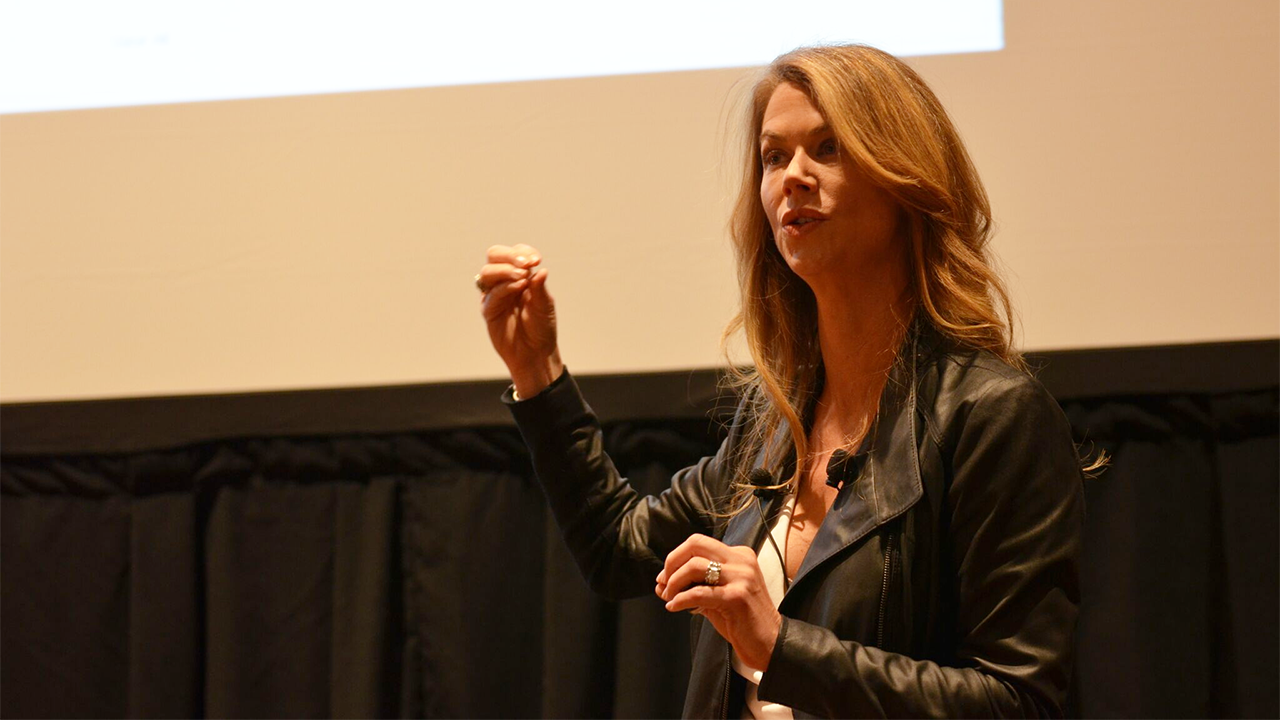Improving Supply Chain and Manufacturing with IoT-Driven Blockchains
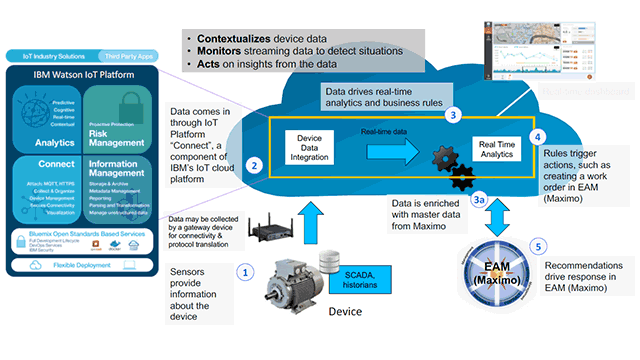
Transformation with blockchain
In almost any industry, an organization’s bottom line is affected by the efficiency of its supply chain. The supply chain’s effectiveness, in turn, is then influenced by factors both predictable and unpredictable. Thus, an organization’s ability to manage and react to these events have a direct effect on the quality of their products and services and also their profitability.
In the previous year, there was a lot of talk about how blockchain would affect several industries. For instance, Everledger already uses blockchain to digitally store the provenance of diamonds to minimize and prevent everything from fraud to conflict stones. There are over 1.2 million diamonds on their blockchain today, which may save insurers up to $50B annually.
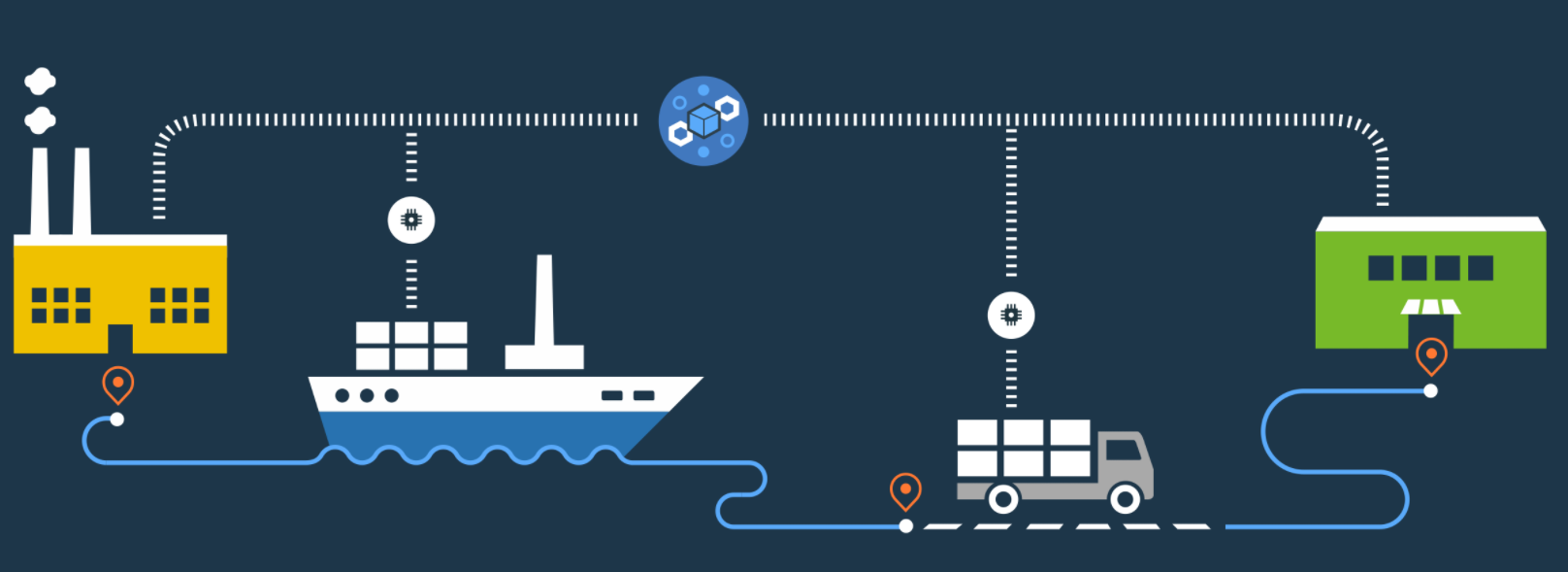 Blockchain in the midst of the shipping workflow (Image credit)
Blockchain in the midst of the shipping workflow (Image credit)Blockchain is believed to have significant impacts on the financial industry. This statement holds true for Canada where major banks and a mint are using the technology to revolutionize finance.
Blockchain is transforming several business sectors and these are just a few of the stories. As IBM thinks, the blockchain technology is here and now. For technology that’s fairly new, blockchain has already seen plenty of success, but is there room for improvement? IBM fellows—David Noller, Rahul Gupta, Jeff Achtermann, James Murphy, Chris O’Connor, Jeanette Barlow, and many others—believe so. This post is based on their vision of how combining blockchain and IoT can lead to a synergy.
“A supply chain that is not able to adapt is at a competitive disadvantage.” —Jeanette Barlow, IBM
IoT in the mix
As the Internet of Things continues to grow, it is becoming common practice to have sensors on individual devices, so data can be communicated among them.
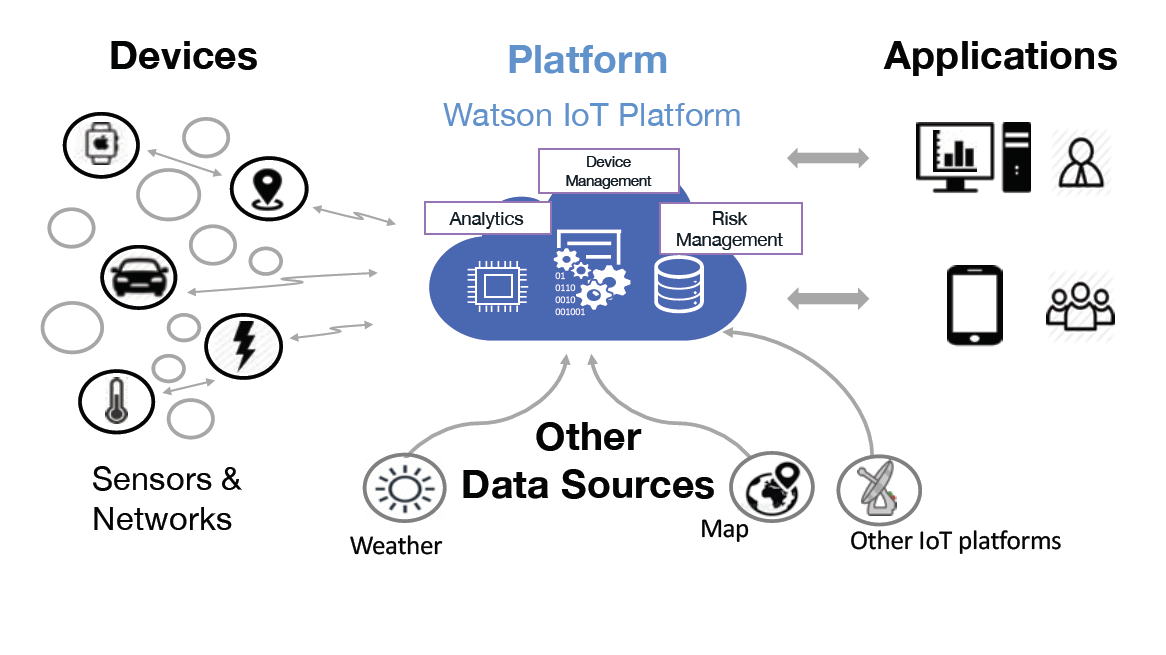 Exchanging data between sensors and apps via IBM Watson (Image credit)
Exchanging data between sensors and apps via IBM Watson (Image credit)What does this have anything to do with blockchain? According to IBM, the Watson IoT platform now comes with blockchain integration (backed by Hyperledger Fabric), effectively combining both technologies.
Watson now “enables devices to send data from these things to private blockchain ledgers for inclusion in shared transactions with tamper-resistant records. Blockchain’s distributed replication allows business partners to verify each transaction, so there’s no longer a need for central control and management. The blockchain records what each participant does and everyone is accountable in the overall transaction.”
Having IoT devices participate in a blockchain, IBM’s document says, will help to:
- “Build a trusted and efficient business network between the people and parties that transact together. Devices can participate in transactions as a party which invokes transactions in the blockchain. The indelible record of transactions and data from devices stored on the blockchain provide proof and command the necessary trust for businesses and people to cooperate.
- Reduce costs of creating, maintaining, and enforcing contracts by sharing information amongst multiple parties. Transactions and device data are now exhibited on a peer-to-peer basis. A peer is a node in Hyperledger that contains a copy of the ledger. Consensus is performed to agree on the state of the blockchain shared ledger.
- Produce a permanent or indelible record required for industry and government regulations.
- Accelerate transactions for improved customer service and enable new business models.”
How will it work?
Through Watson IoT Platform, physical devices could be allowed to participate in blockchain transactions. This will enable new methods of automating business processes among business network participants without requiring a centralized IT infrastructure.
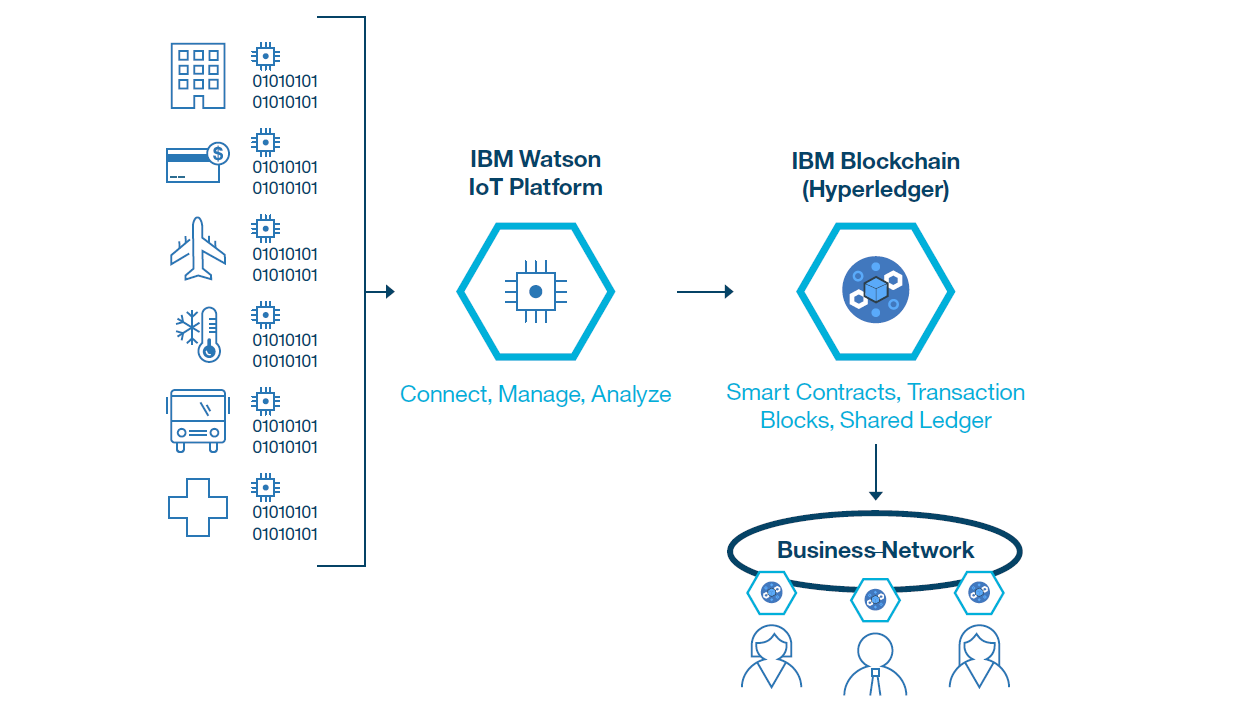 Source
SourceWith IoT devices acting as participants, blockchains can:
- Enable business networks to use IoT devices to supply data to blockchain transactions.
- Abstract devices from contracts. Watson IoT Platform can provide data mapping and filtering between devices and blockchain contracts.
In this instance, IoT devices could send anything from GPS coordinates to temperature data to register or update events.
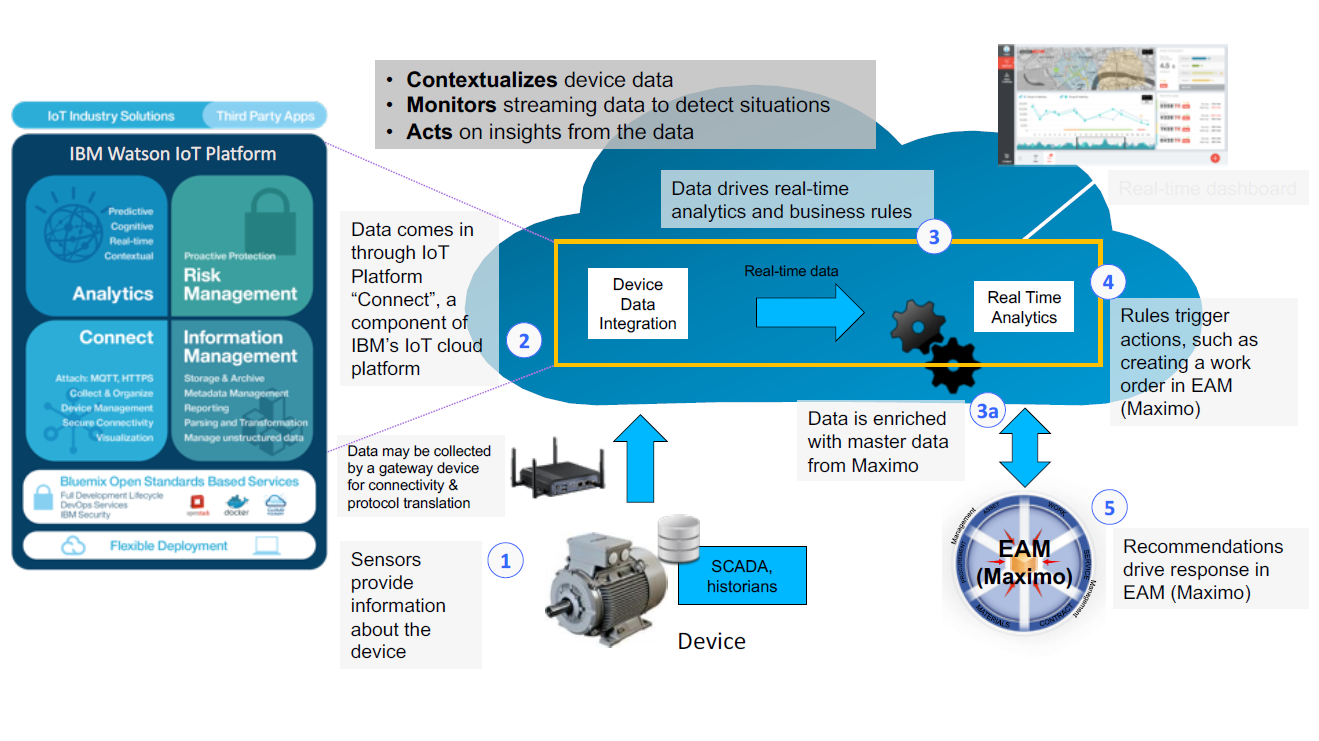 Source
SourceNot all IoT device events have to go to blockchain, the Watson IoT platform can be configured to filter and include only key events that are worth sharing and recording.
The combination of both blockchain and IoT provides several benefits, according to IBM’s Chris O’Connor:
- Supply chain. Track objects as they traverse the export/import supply chain while enforcing shipping and line of credit contracts and expediting incremental payments.
- Parts tracking/history. Maintain indelible history of parts and end assembly through supply chain, potentially including critical events that affect life or scheduled maintenance.
- Decentralized edge computing. Securely run computing workloads, such as analytics, on edge devices owned by third parties.
- Interconnecting devices. Enable distributed devices to request and pay for services through distributed role management and micropayments.
- Regulatory compliance. Track equipment or process history in an indelible record and enable easy sharing of this information with regulatory agencies or insurers.
The following architecture demonstrates what components are required for building an IoT-blockchain integrated environment (based on the IBM Bluemix stack).
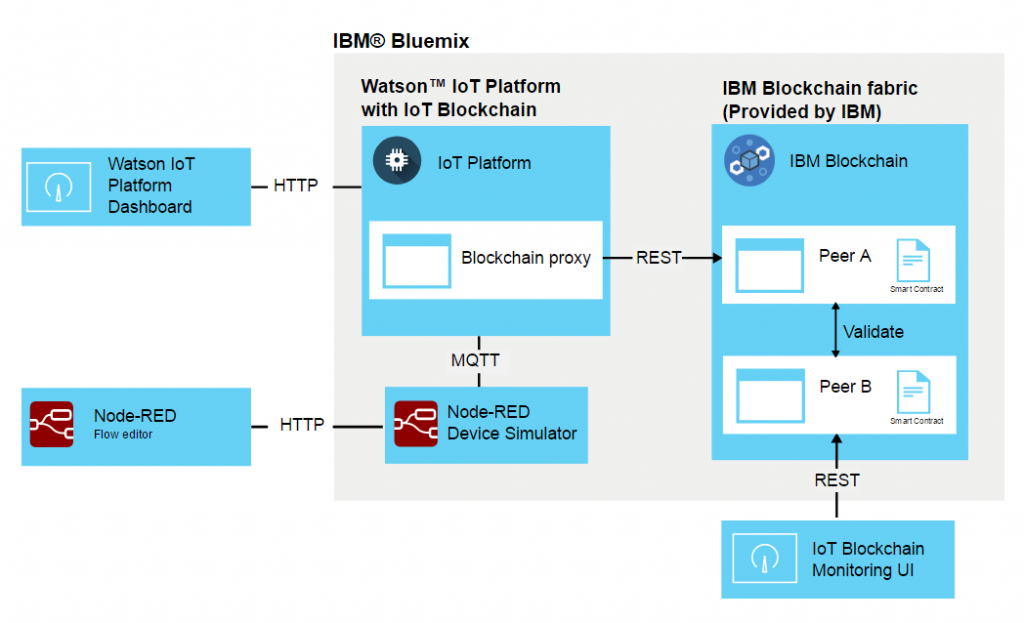 Image credit
Image credit
Tracking goods in a supply chain
One of the simplest use cases, where IoT and blockchain provides value, is in the shipping and tracking of goods in a supply chain or a manufacturing process. IoT-enabled packages transmit required status information along the way and how each transaction is tracked and shared among all partners in a blockchain.
In this scenario, the platform can be configured to run events in real time:
- Alert the factory that the shipment had arrived at the grocery store
- Automatically trigger payments to be made by the factory to the carriers
- Automatically generate an invoice to be sent to the grocery store
According to Rahul Gupta, another scenario may involve an elevator manufacturing company, which allows its customers and government agencies to participate in the established blockchain network. This way, the elevator manufacturing company installs elevators at their customer location and configures the elevator device data to be sent into a blockchain using an IoT platform. Further on, this data can be exploited by:
- the elevator manufacturer to detect any malfunctions, thus improving customer service
- the government agencies for inspection and security compliance
None of the parties have to request data from each other. What’s more, once data reaches blockchain, noone can change it.
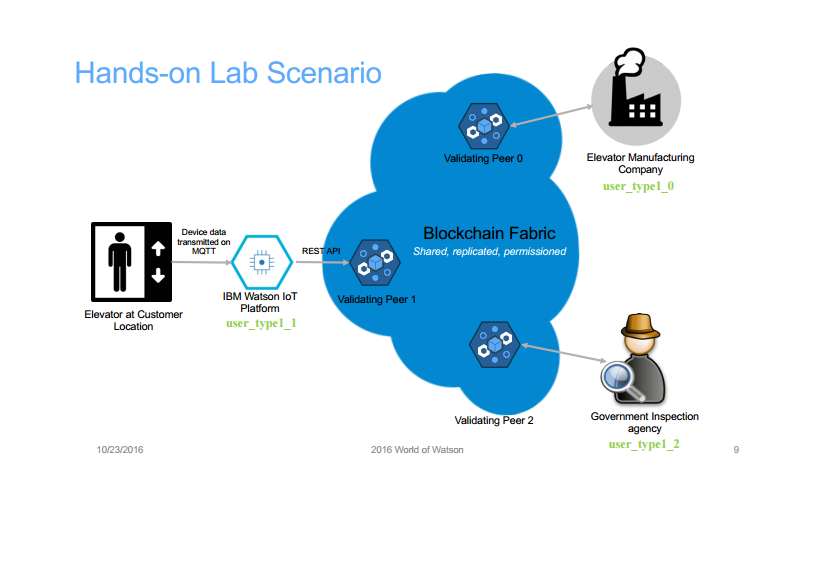 A sample scenario involving an elevator manufacturer (Source)
A sample scenario involving an elevator manufacturer (Source)Other use cases include, according to the presentation by Jeff Achtermann and James Murphy:
| Industry | Use Case | Shared Data | Parties |
| Shipping/Logistics | Monitor shipping logistics, share shipping documents | Location, cargo properties, shipping documents | Sender, receiver, freight companies, customs, and banks |
| Part life-cycle tracking and maintenance | Track part provenance from manufacture to end of life | Part identification, usage and maintenance information | Part manufacturer, final assembly manufacturer, repair organization, owner, and regulatory agency |
| Regulatory compliance | Share documents with a regulatory agency and the public on a blockchain | Compliance documentation, usage and maintenance information | Regulatory agency and appropriate industry manufacturers and operators |
| Building management | Permanent record of building access and usage | Log of building systems, human access | Building owner, building tenant, and building management |
| Energy | Track and trade carbon credits on a blockchain | Carbon credits and production | Members of the carbo credit exhange and the public |
Data analysis to come
Through the integration of IoT, an already efficient blockchain network can be improved even further. IBM is also working on adding analytics on top of blockchain.
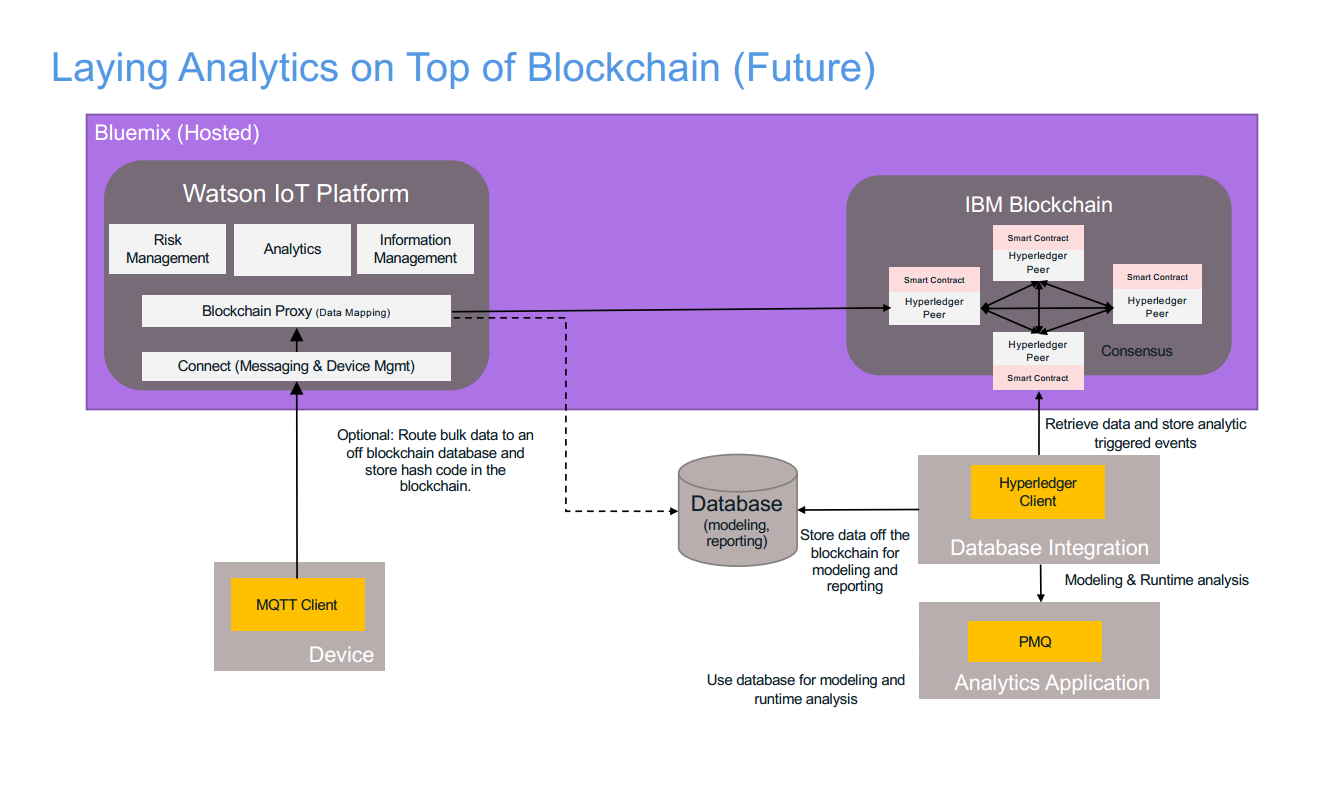 Source
SourceFrom that point, this may be another story.
Check out IBM Bluemix/Watson documentation for technical details of how IoT can be coupled with blockchain/Hyperledger.
Related video
Related reading
- IBM: The Time for IoT, AI, and Machine Learning Is Now
- IBM: Blockchain to Transform IoT, Supply Chains, and the World Around Us
- The “Internet of Value”: 8 Top Sectors Being Transformed by Blockchain
About the speakers



